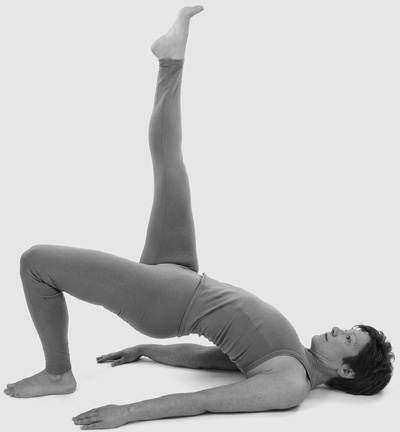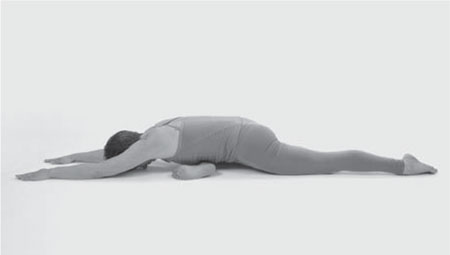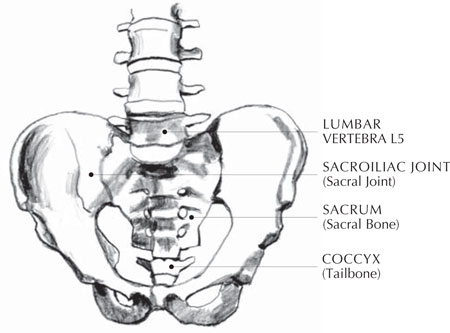Yoga for a Healthy Lower Back (15 page)
Read Yoga for a Healthy Lower Back Online
Authors: Liz Owen

Triangle Pose opens and broadens your hips, elongates your spinal muscles, and strengthens your legs and spine. It's often the first standing pose presented in many yoga classes, yet it's notoriously challenging for those with sacral and hip issues. But its benefits make the pose very worthwhile to practice.
One-Legged Bridge Pose
Strengthen | Eka Pada Setu Bandha Sarvangasana
Once your lower back is comfortable in
Bridge Pose
, you're ready try a variation that increases the strengthening component of the pose. You'll feel more work in your back hip muscles as well as in the thigh of
your grounded leg. It also helps to strengthen the psoas (hip flexor) muscle of the lifted leg. I'll offer two ways to move into the pose; try them in sequence, then decide which feels right for your body.
Variation 1: Pre-Bridge Lift
This is often a more accessible variation for most people, so I recommend starting here. Lie on your back and prepare for Bridge Pose by placing your feet on the floor about hips' width apart and one foot from your hips. Move your left foot slightly to the right and ground it firmly to the floor. On an inhalation, bend your right knee into your chest, and on an exhalation straighten it up toward the sky. With your next exhalation, lift your hips up into Bridge Pose (
fig. 2.26
). Stay in One-Leg Bridge for ten to twenty seconds, pressing your left foot strongly down into the floor and lifting your hips and back any amount possible. Come out by slowly lowering your hips to the floor, bend your right knee into your chest, and place your right foot down on the floor. Hug your knees into your chest and take a few breaths, then repeat on the other side, lifting your left leg.
Variation 2: Bridge Lift
Come up into Bridge Pose. On an inhalation, bend your right knee into your chest, and with your exhalation, straighten your right leg up to the ceiling. Hold One-Leg Bridge Pose for ten to twenty seconds, and come out by bringing your right leg back down toward your chest, placing your right foot on the floor (you will briefly be in traditional Bridge), and finally lowering your back body down to the floor. Be sure to take a moment to hug your knees into your chest before you repeat the posture on the opposite side. This variation can be more challenging because your hips and back are up in the air and unsupported when you raise and lower the lifted leg. The virtue of this variation is that it is highly strengthening because it asks for more muscular work, as you hold your hips and back body up for a longer time.

FIG. 2.26
Resting Swan Pose
Stretch | Eka Pada Raja Kapotasana Variation
Now it's finally time to let your hips release after they've accomplished such strengthening work. Resting Swan Poseâa variation on the classic hatha yoga pose called One-Legged King Pigeonâis one of the most luscious of hip stretches. With the right amount of support under your hips and a deep, flowing rhythm of breath, your hips will let go of stress and holding. You can imagine your body opening up so that you can move in toward your innermost self, like a swan softly lifting her wings before she draws herself inward and rests her head on the downy softness of her body.
Start on all fours. Bring your right foot forward and walk it over to the left, between your left hand and knee. Press your hips forward and take your right outer shin and thigh down to the floor. Adjust your right leg so your knee is slightly to the right of your right hip, and your right shin and foot point to your left thigh. Curl your left toes under, and, engaging your thigh muscles, lift up your left knee and walk your left foot back, shifting your hips back as you move. Do this two or three times, stopping for a few breaths between each step to be sure the stretch in your hip is sustainable.
With your left outer hip pressing forward, see if your right hip can descend to the floor. Draw both your thighs toward your hipsâthis action helps balance your sacral joints and hips, and helps loose sacral joints to feel stable. Take your left hand onto your outer left hip and press it forward again, to make sure your hips are as balanced as possible. Place your fingertips on the floor slightly forward of your torso and elongate your whole spine upward. You should feel a stretch deep in your right hip, but you should not feel discomfort or strain in your lower back. In case of discomfort, walk your hands farther away from your torso to elongate your lower back more. Slowly walk your hands forward, bend forward over your right leg and rest your head on the floor or on a block (
fig. 2.27
).

FIG. 2.27
Stay in this pose for one to three minutes before repeating with your left leg forward and right leg back.
TIP FOR A COMFORTABLE RESTING SWAN POSE
If the stretch of Resting Swan Pose is too intense in your hips, take your right hip higher with the support of one or two folded blankets, and place your hands on blocks to lift your spine fully before you fold forward. When you find the best height for your hip, the stretch will be present but not overwhelming, one that you can stay in and experience fully in your body.
Breathe deeply into your hips and feel the deep hip muscles starting to relax with each breath. It can take a while to connect with the true depth of hip musculature you're working with, so patience is a true virtue in this pose! If you have time, repeat the pose to each side and you will see and feel an immediate changeâyour hips should be more open and fluid, and they may drop down a little bit more toward the floor on your second round. More importantly, your mind will be softer and quieter as you rest and release.
Deep Hip Meditation, Child's Pose, and Deep Relaxation
Rest | Balasana and Shavasana Variation 1
It's important to take time to rest fully when you're done with your hips practice in order to let the work of the poses percolate into the deepest layers of your body. Lie down on your back and repeat the
Deep Hip Meditation
. Check in with your hips, explore them, and acknowledge the sensations that ariseâyou might find a very different feeling from when you practiced the meditation at the beginning of your journey into healthy hips. If there is any tenderness in your lower back or sacrum, repeat
Child's Pose
. Finish with five to ten minutes of
Deep Relaxation
.
3
SACRUM MAY BE A
word you had rarely, if ever, heard before you picked up this book. That's because, in my opinion, the sacrum is the single most neglected area of the modern human body.
The typical contemporary lifestyle does not value or prioritize physical positions and movements that are healthy for the sacrum, and if you do a quick review of your own activities over the past few days or even hours, you'll likely agree. Did you flop onto the couch to watch TV during that time? You were probably overly rounding your sacral bones, “stretching” them, but not in a productive, yogic way. Ditto for all that slouchy computer time you've logged recently, which pushes your sacral joints backward so that they almost flop open (again, not in the “open” way we're going for!). Have you ever felt a broad ache spread across your tailbone during a stressful meeting or tense conversation? Those are your muscles around your sacrum clenching, tightening, and stiffening under the weight of un-coped-with stress.
In this chapter you'll find yoga sequences to make you aware of your sacrum and its role in your body. You'll discover ways to bring movement, fluidity, and space into your sacrum, regardless of whether your problem is an overextended sacrum or a tightly wound one. This chapter and the next are partners, in a way, in that the poses in this chapter may also be helpful for your lumbar spine, and the poses in chapter 4 may be helpful for your sacrum. Practice the poses in this chapter first, then move on to the poses in chapter 4 for comprehensive strengthening and toning of your entire lower back.
WHAT'S A SACRUM?
“During my first yoga class my teacher kept referring to the âsacrum.' Having no idea what she was talking about, I ran home and looked the word up in the dictionary . . . and still didn't understand what or where it was. I think it took a couple of years after that before I knew where the sacrum was. Now I lecture on spinal anatomy! Understanding the anatomy of pain demystifies it. Understanding which misalignments it stems from, and which nerves it affects helps me to interpret my pain as sensation, and not as something to take personally.”
âDEBORAH WOLK, scoliosis expert and yoga teacher
As you read and practice, keep in mind the most fundamental thing I can teach you about the sacrum: its root is the Latin word
sacer,
which means “holy,” or “sacred.” In addition to its other, religious meanings,
sacred
means “separate,” and although your sacrum is connected to your hip bones and lumbar spine, as we begin to practice, I want you to think about your sacrum as an entity unto itself, worthy of your special attention, protection, and kindness. If you treat your sacrum with the reverence it deserves, you will find within it a reservoir of wellness and wholeness that will spread throughout the rest of your back and your whole body.
T
HROUGH
W
ESTERN
E
YES: THE
P
HYSICAL
V
IEW
Your sacrum is a perhaps the most elegant example of the architecture of the human form. For one thing, it is the gateway into the central core of the body, located midway between your feet and head. If your hips are a bridge between your two legs, then your sacrum is the bridge's crown, the keystone that allows the bridge to evenly transfer weight from your head, shoulders, and trunk through your hip bones to your legs.
The design of the sacrum, structurally speaking, is brilliant: its central location and system of attachment to the upper and lower bodies creates an efficient system of distributing forces with as little impact on joints and myofascia as possible. Well, to be fair, that's only true if your hips, sacrum, and spine are in balance. If they aren't, the sacrum can be irksome at best, at worst a source of constant pain and discomfort that can affect your emotional outlook on life.

Illustration 8. Your Sacrum and Sacral Joints
The five sacral vertebrae are separate at birth, then, starting at puberty, they become fused together to form a single triangular bone that is strong enough to carry the weight of your whole body.
1
Think of your sacral bone as the bone that anchors your spine into the back of your hips.
Each time you take a step, the weight of your torso comes down into the sacrum and is transferred into your hips by the joints between the sacral bone and your hip bones, called the sacral joints. Your weight is then channeled through your legs down to the earth. In this way, the sacrum acts as a kind of shock absorber that softens the impact of both downward, gravitational forces and the upward movement of the force of your body's contact with the ground throughout your day. Your sacrum is the very center of physical activityâand, for that matter, restâwithin your body. In that way, I consider the sacrum to be the “heart” of your spine.
